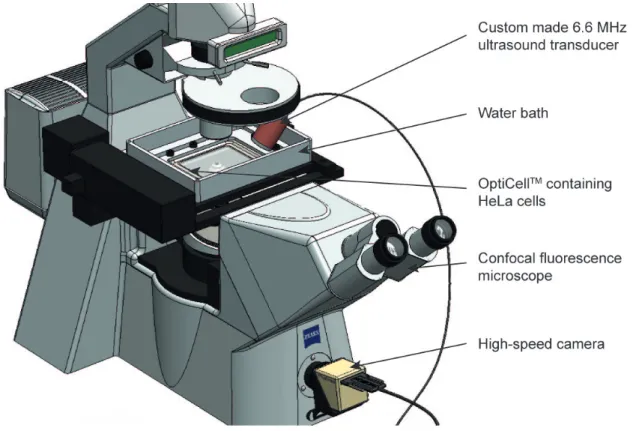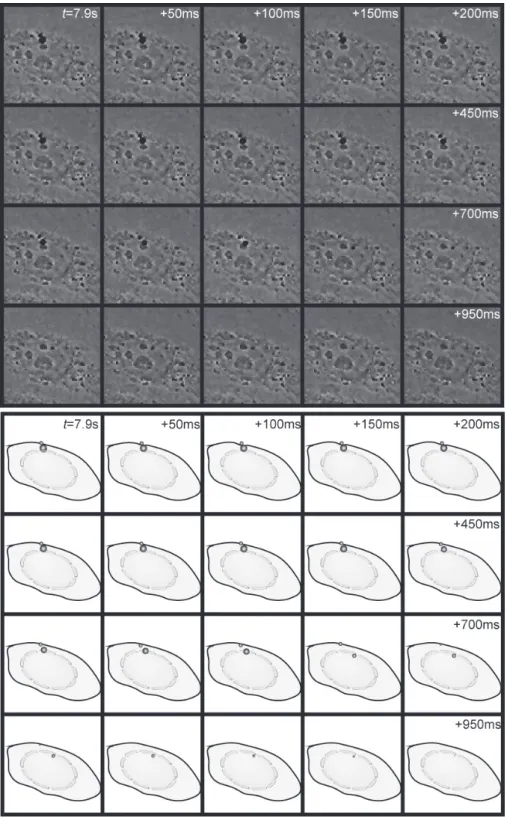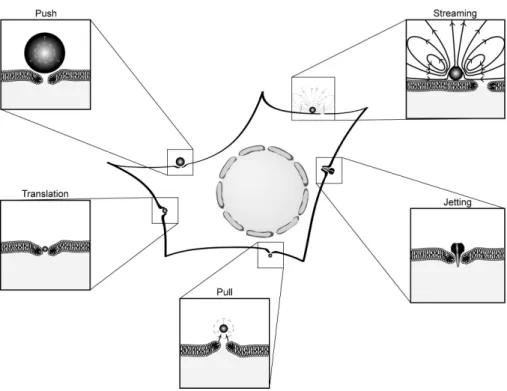HAL Id: hal-03195601
https://hal.archives-ouvertes.fr/hal-03195601
Submitted on 11 Apr 2021HAL is a multi-disciplinary open access
archive for the deposit and dissemination of sci-entific research documents, whether they are pub-lished or not. The documents may come from teaching and research institutions in France or abroad, or from public or private research centers.
L’archive ouverte pluridisciplinaire HAL, est destinée au dépôt et à la diffusion de documents scientifiques de niveau recherche, publiés ou non, émanant des établissements d’enseignement et de recherche français ou étrangers, des laboratoires publics ou privés.
Nonlinear microbubble behaviour for enhanced drug
uptake
Spiros Kotopoulis, Anthony Delalande, Chantal Pichon, Michiel Postema
To cite this version:
Spiros Kotopoulis, Anthony Delalande, Chantal Pichon, Michiel Postema. Nonlinear microbubble behaviour for enhanced drug uptake. 19th International Congress on Sound and Vibration, Vilnius, Lithuania, July 8–12, 2012, Jul 2012, Vilnius, Lithuania. pp.685. �hal-03195601�
ENHANCED DRUG UPTAKE
Spiros Kotopoulis
1,4, Anthony Delalande
2,4, Chantal Pichon
3and
Michiel Postema
41National Centre for Ultrasound in Gastroenterology, Haukeland University Hospital,
5021 Bergen, Norway
2Haematology Section, Institute of Medicine, University of Bergen, 5021 Bergen, Norway 3Centre de Biophysique Mol´eculaire, UPR 4301 CNRS, Orl´eans, France
4Department of Physics and Technology, University of Bergen, 5007 Bergen, Norway
The purpose of this study was to investigate the physical mechanisms of sonoporation, to understand and ameliorate ultrasound-assisted drug and gene delivery. Sonoporation is the transient permeabilisation of a cell membrane with the help of ultrasound and/or an ultra-sound contrast agent, allowing for the trans-membrane delivery and cellular uptake of macro-molecules between 10 kDa and 3 MDa.
We studied the behaviour of ultrasound contrast agent microbubble near cancer cells at low acoustic amplitudes. After administering an ultrasound contrast agent, HeLa cells were sub-jected to 6.6-MHz ultrasound with a mechanical index of 0.2 and observed using a high-speed camera.
Microbubbles were seen to enter cells and rapidly dissolve. The quick dissolution after enter-ing suggests that the microbubbles lose (part of) their shell whilst enterenter-ing.
We have demonstrated that lipid-shelled microbubbles can be forced to enter cells at a low acoustic amplitude. Hence, if a therapeutic load is added to the bubble, ultrasound-guided de-livery could be facilitated at diagnostic settings. However, these results may have implications for the safety regulations on the use of ultrasound contrast agents for diagnostic imaging.
1.
Introduction
Ultrasound contrast agents are commonly added to the blood stream in ultrasonic imaging: contrast-enhanced ultrasound (CEUS). They consist of microscopically small bubbles (microbub-bles) encapsulated by elastic shells. The most common shell materials are phospholipids. During an ultrasound cycle microbubbles oscillate, i.e., they expand and subsequently contract. Depending on their elastic properties, on the local conditions, and on the acoustic settings, they move in the direc-tion of the sound field, coalesce with other microbubbles, fragment, jet, cluster, release their contents, and dissolve in the surrounding liquid [1]. The diverse behaviour of encapsulated microbubbles in different acoustic regimes has triggered the idea to use them as ultrasound-controlled vehicles to facilitate the delivery of therapeutic agents to a site of interest. Such a noninvasive, localised, side-effect-free method would revolutionise drug delivery as we know it. Cellular uptake of drugs and deoxyribonucleic acid (DNA) is increased when the region of interest is under sonication, and even more so when an ultrasound contrast agent is present [2]. This increased uptake has been attributed
19th International Congress on Sound and Vibration, Vilnius, Lithuania, July 8–12, 2012
to the formation of transient porosities in the cell membrane that have diameters up to 0.1 µm, i.e., big enough for the transport of drugs into the cell. The pores reseal themselves within one minute. The ultrasound-assisted transient permeabilisation of a cell membrane is called sonoporation. Un-derstanding the physics underlying sonoporation is of uttermost importance for the development of ultrasound-activated therapeutic agents.
2.
Materials and methods
Figure 1 shows the setup used to simultaneously observe and sonicate the cells. A signal con-sisting of 50 cycles with a centre frequency of 6.6 MHz and a pulse repetition frequency of 10 kHz, i.e. 7.5% duty cycle, was used. The ultrasound was generated by a custom made ultrasound transducer with a hexagonal lithium niobate y–36◦ cut active element with a maximum diameter of 25mm. The peak-negative acoustic pressure was measured to be 0.5 MPa in a separate tank and in the sonication chamber itself. This corresponded to an MI of 0.2.
HeLa cancer cells were seeded onto a single side of an OptiCell R cell culture chamber.
Ultra-sound contrast (MicroMarkerTM, VisualSonics B.V., Amsterdam, The Netherlands) agent was injected into the OptiCell R prior to sonication resulting in a dilution of 3.33% v/v. The ultrasound contrast
agent was labelled using a DiD [DilC18(5)] lipophilic probe (Vybrant
TM
Molecular Probes, Invitrogen, San Diego, CA, USA) to allow microbubble tracking post-sonication. The OptiCell R
was then placed into a custom made water bath designed to fit in the x-y stage of a 200M inverted confocal microscope (Carl Zeiss AG, Oberkochen, Germany) coupled to a Axiovert 510 scanning stage (Carl Zeiss AG). Observations were made using a EC Plan-Neofluar 40×/1.30 Oil DIC M27 objective.
A Photron FastCam MC-2.1 high-speed camera (VKT Video Kommunikation GmbH, Pfullin-gen, Germany) was coupled to the C-mount of confocal fluorescence microscope.
Figure 1. Close up of experimental setup showing configuration for simultaneous sonication and observation using a high-speed camera.
3.
Results
Fluorescence-coated ultrasound contrast agent microbubbles were observed to move into HeLa cells at a low mechanical index (MI) of 0.15, using highspeed video footage under confocal mi-croscopy [3] an example of which is given in Figure 2. The microbubbles dissolved after entering the cells. The cells survived the sonoporation treatment, confirming the transient character of sonopora-tion.
Figure 2. Typical sonoporation event showing two microbubbles translate into a HeLa cell and subsequently dissolving (top) and graphical representation (bottom).
19th International Congress on Sound and Vibration, Vilnius, Lithuania, July 8–12, 2012
4.
Discussion
Figure 3. Schematic representation of the five physical mechanisms supposedly involved in sonoporation. There are five non-exclusive hypotheses for explaining the sonoporation phenomenon from a physics point of view [4]. These have been summarised in Figure 3. It is noted that fragmenting microbubbles cannot create pores in cells, since fragmentation costs energy. (a) Push: During its ex-pansion phase, a microbubble might touch a cell membrane surface. The pushing motion would then cause the cell membrane to be locally disrupted. The pushing mechanism would occur within half an ultrasound cycle. However, under typical sonication conditions, microbubble excursion amplitudes are low. Also, typically, microbubbles are much more flexible than cells. Our current understand-ing of microbubble physics does not support the push mechanism if the microbubble is not attached. However, if the microbubble is already attached to the cell membrane whilst expanding, pushing un-der influence of radiation forces might cause the membrane to rupture. The latter mechanism might occur over multiple cycles. (b) Pull: During the contraction phase of an oscillating microbubble, the plasma filling the void left by the contracting bubble might pull the cell membrane towards the microbubble. This pulling motion would then cause the cell membrane to be locally disrupted. The pulling mechanism would occur within half an ultrasound cycle. However, under typical sonication conditions, microbubble contractions do not result in an inertial collapse. Moreover, the replacive mass of a contracting microbubble is much lower than the fluid supposedly causing the pull. There-fore, this mechanism is less plausible than the push mechanism in non-attached conditions. However, if the microbubble is attached to the cell membrane, a similar mechanism might occur as described under (a), where pulling under the influence of radiation forces might cause the membrane to rupture. (c) Jetting: Jetting is the asymmetric collapse of a bubble, creating a funnel-shaped protrusion through the bubble that is directed towards a boundary. This spectacular phenomenon has actually been opti-cally observed on a microscopic scale through cells [5]. The jetting phenomenon occurs within half an ultrasound cycle. However, jetting exclusively occurs when using high acoustic amplitudes, at the upper end of clinical settings. Also, there has not been any proof yet of cell survival after jetting. Based on empiric studies that relate jet length to pore size, we excluded the role of jetting as a domi-nant mechanism involved in sonoporation [6] (d) Streaming: If a microbubble is fixed to a membrane, the fluid streaming around the oscillating bubbles creates enough shear to rupture the membrane [7].
Here, long pulse lengths are required to set the fluid in motion. However, low acoustic amplitudes should suffice to create the rupturing shear of a typical cell membrane. Existing research has proven the feasibility of the streaming mechanism in bound conditions, so this mechanism should work for targeted contrast agents that attach to cells. Further research will show whether streaming around weakly-attached microbubbles creates enough shear for cell membranes to rupture. (e) Translation: Owing to radiation forces, lipid-encapsulated microbubbles may translate through cell membranes or channels in the cell membrane. The microbubble may loose part of its shell whilst passing through the cell membrane. As a result, the gas will dissolve after entry. In case of therapeutic loading, the load would be delivered directly into the target cell. This mechanism requires long pulse lengths and low acoustic amplitudes.
5.
Conclusion
All five of these mechanisms require the presence of a microbubble in the vicinity of the cell. Yet, increased drug uptake has also been reported without the use of any ultrasound contrast agent, but merely an ultrasound field itself. Despite speculations about the role of inertial cavitation in the latter, clinical ultrasound scanners do not generate fields strong enough to create such spontaneous microbubbles in blood. Recently, it was found that (bilayer) cell membranes themselves act as cavita-tion nuclei [8]. Even at modest acoustic pressures, cell membranes might rupture due to the building up of gas cavities inside the bilayer. This important finding would explain the sonoporation in the ab-sence of ultrasound contrast agent microbubbles. Moreover, it explains why bubbles are attracted to cells that are not in the travel path of the ultrasound wave. However, given the low MI at which cells attract microbubbles, more study is required regarding the safe use of ultrasound contrast agents in longpulse-length imaging. In conclusion, in current clinical settings, four non-exclusive mechanisms are plausible for the physical explanation for sonoporation with the aid of ultrasound contrast agent microbubbles.
6.
Acknowledgements
This work has been supported by the Meltzers Høyskolefond.
Bibliography
1 M. Postema and O. H. Gilja. Contrast-enchanced and targeted ultrasound. World J. Gastroenterol.,
17(1):28–41, 2011.
2 M. Postema and O. H. Gilja. Ultrasound-directed drug delivery. Curr. Pharm. Biotechnol.,
8(6):355–361, 2007.
3 A. Delalande, S. Kotopoulis, T. Rovers, C. Pichon, and M. Postema. Sonoporation at a low
me-chanical index. Bub. Sci. Eng. Tech., 3(1):3–11, 2011.
4 M. Postema, O. H. Gilja, and A. van Wamel. CEUS and sonoporation, pages 205–217. Spon press,
London, 2011.
5 P. Prentice, A. Cuschieri, K. Dholakia, M. Prausnitz, and P. Campbell. Membrane disruption by
optically controlled microbubble cavitation. Nature Phys., 1:107–110, 2005.
6 M. Postema and O. H. Gilja. Jetting does not cause sonoporation. Biomed. Eng., 55:S19–S20,
19th International Congress on Sound and Vibration, Vilnius, Lithuania, July 8–12, 2012
7 P. Marmottant and S. Hilgenfeldt. Controlled vesicle deformation and lysis by single oscillating
bubbles. Nature, 423:153–156, 2003.
8 B. Krasovitski, V. Frenkel, S. Shoham, and E. Kimmel. Subcellular sonophores: ultrasound induced
intramembrane cavitation. Proc. Nat. Acad. Sci., 108(8):3258–3263, 2011.


